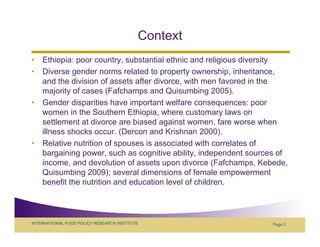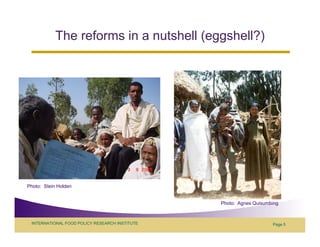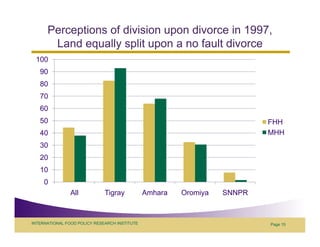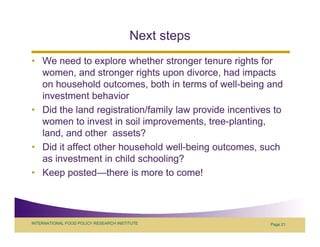Quisumbing kumar land_conf
- 1. Land registration and p g policy reforms y toward gender equality in Ethiopia Neha Kumar Agnes R Quisumbing Poverty, Hunger and Nutrition Division (PHND), IFPRI Annual Bank Conference on Land Policy and Administration y April 26-27, 2010
- 2. Kes be kes enqullal be-egrwa tihedalech INTERNATIONAL FOOD POLICY RESEARCH INSTITUTE Page 2
- 3. Context • Ethiopia: poor country, substantial ethnic and religious diversity • Diverse gender norms related to property ownership, inheritance, and the division of assets after divorce, with men favored in the majority of cases (Fafchamps and Quisumbing 2005). • Gender disparities have important welfare consequences: poor women in the Southern Ethiopia, where customary laws on settlement at divorce are biased against women, fare worse when illness shocks occur. (Dercon and Krishnan 2000). • Relative nutrition of spouses is associated with correlates of bargaining power, such as cognitive ability, independent sources of income, and devolution of assets upon divorce (Fafchamps, Kebede, Quisumbing 2009) several di Q i bi 2009); l dimensions of f i f female empowerment l t benefit the nutrition and education level of children. INTERNATIONAL FOOD POLICY RESEARCH INSTITUTE Page 3
- 4. Policy reform: An opportunity for increased g gender equality? q y • Changes in legislation may improve well-being outcomes for women. Example: In Canada, suicide rates of p , married women are lower in states with divorce laws that are more beneficial to women (Hoddinott and Adam). • In Ethiopia the recent Land Registration process ( 2003 Ethiopia, (~ onwards) led to joint certification of husbands and wives, giving stronger land rights to women • The revised Family Code, passed in 2000, gave equal rights to women and men in terms of marriage, inheritance and property property. • To what extent do these policy reforms reinforce each other? INTERNATIONAL FOOD POLICY RESEARCH INSTITUTE Page 4
- 5. The reforms in a nutshell (eggshell?) Photo: Stein Holden Photo: Agnes Q Quisumbing INTERNATIONAL FOOD POLICY RESEARCH INSTITUTE Page 5
- 6. Land registration g •Land certification in Ethiopia was carried out through a low-cost, rapid, and transparent process •Land administration committees at kebele level were required to have at least one female member (although variations in compliance) compliance). •Land certificates were issued after public registration for transparency. •Land certificates i l d maps and pictures of L d ifi include d i f husband and wife, though there were regional variations. See Deininger et al. (2007), work by Holden and colleagues for more INTERNATIONAL FOOD POLICY RESEARCH INSTITUTE Page 6
- 7. Family Law • At the federal level, a new Family Code based on the principle of gender equality came into effect in mid-2000 • However, constitutional recognition gave full , g g sovereignty to seven regions out of nine, each having its own family law. Six regional governments continue to apply the previous law law. • Assets brought to marriage remain the property of each spouse upon divorce • Common property to be divided 50:50 upon divorce INTERNATIONAL FOOD POLICY RESEARCH INSTITUTE Page 7
- 8. Objectives of this paper • Using a recently collected round (2009) of the Ethiopian Rural Household Survey, we explore: y, p 1. differences in the awareness, participation, and perception of land registration process between male- male and female-headed ho seholds female headed households; 2. determinants of awareness, participation and p perception of the land registration p p g process 3. determinants of changes in perceptions regarding the division of assets (land and livestock) upon divorce di • Explore role of initial wealth, social networks, regional variations in explaining these differences INTERNATIONAL FOOD POLICY RESEARCH INSTITUTE Page 8
- 9. Data INTERNATIONAL FOOD POLICY RESEARCH INSTITUTE Page 9
- 10. There is regional variation in female headship… Figure 2. Proportion of Female Headed Households 0.7 0.6 0.5 0.4 0.3 0.2 0.1 0 INTERNATIONAL FOOD POLICY RESEARCH INSTITUTE Page 10
- 11. …and in resources of FHHs and MHHs FHH MHH P- value Age of head 54.3 52.5 ** Highest grade obtained 4.76 6.28 *** Household size 4.39 6.38 *** Total land owned (hectares) 1.73 2.20 *** Total livestock owned (TLUs) 8.82 9.39 *** Per capita consumption in 2004 (birr) 94 91 Prop household belonging to iddir 0.76 0.89 *** Network size 8.61 11.41 *** Number of sources from which hh can borrow 1.32 1.57 *** *** significant at 1%, ** at 5%, * at 10% INTERNATIONAL FOOD POLICY RESEARCH INSTITUTE Page 11
- 12. While differences in land management are statistically significant, magnitudes are similar g 1.2 1 0.8 0.6 0.4 FHH 0.2 MHH 0 Fraction of Fraction of Fraction of Fraction of Fraction of total land total land pp cropped cropped pp total area cropped that is fertile area area registered operated by registered women INTERNATIONAL FOOD POLICY RESEARCH INSTITUTE Page 12
- 13. Gender differences in awareness of land regisration process % hhs aware of land % hhs attending meetings registration during land registration 1.2 1.2 1 1 Female Female Headed Headed 0.8 0.8 08 0.6 Male Headed 0.6 Male Headed 0.4 0.4 0.2 0.2 0 0 Whole Amhara Oromiya SNNPR Whole Amhara Oromiya SNNPR Sample Sample INTERNATIONAL FOOD POLICY RESEARCH INSTITUTE Page 13
- 14. Index of participation in land registration process 4 3.5 3 2.5 2 Female Headed Male Headed 1.5 1 0.5 05 0 Whole Sample Tigray Amhara Oromiya SNNPR INTERNATIONAL FOOD POLICY RESEARCH INSTITUTE Page 14
- 15. Perceptions of division upon divorce in 1997, Land equally split upon a no fault divorce 100 90 80 70 60 50 FHH 40 MHH 30 20 10 0 All Tigray Amhara Oromiya SNNPR INTERNATIONAL FOOD POLICY RESEARCH INSTITUTE Page 15
- 16. Changes in perceptions of division upon divorce: Moved towards equality of division of land, 1997-2009 q y , 70 60 50 40 FHH 30 MHH 20 10 0 All Tigray Amhara Oromiya SNNPR INTERNATIONAL FOOD POLICY RESEARCH INSTITUTE Page 16
- 17. Summary of regression results on land registration (with PA fixed effects) Knowledge of Attendance at Index land registration meetings Highest grade in Positive hh Plot area, 2004 Negative Negative Lowest land Negative quartile, 2004 3rd land quartile, Negative 2004 Any female Positive Positive members in LAC Member f iddir, M b of iddi Positive P ii Positive P ii 2004 INTERNATIONAL FOOD POLICY RESEARCH INSTITUTE Page 17
- 18. Summary of regression results on family law (with PA fixed effects) Move to split land Move to split 50:50 livestock 50:50 Plot area, 2004 Negative Negative Any female members in Positive Positive LAC Member of iddir, 2004 Negative Negative INTERNATIONAL FOOD POLICY RESEARCH INSTITUTE Page 18
- 19. Concluding remarks--1 • Our analysis confirms gender gaps in awareness and information about the land registration process • Male headed households are on average more likely to have heard about the land registration process, attended meetings (and a greater number) and have received some written material with information about th process i f ti b t the • The presence of female members in the LAC encourages participation by female headed households and does not discourage participation b male h d d h ti i ti by l headed households. h ld • Social networks also matter • Land registration process does not seem to discriminate against the poor (in terms of landholdings) INTERNATIONAL FOOD POLICY RESEARCH INSTITUTE Page 19
- 20. Concluding remarks--2 • Awareness about the land registration process is positively correlated with the shift in perceptions towards equal division of land and li d livestock upon di t k divorce, particularly f male h d d h ti l l for l headed households. h ld • Presence of female members in the LAC has a positive effect on the changes in perceptions towards a more equal distribution of assets upon didivorce. • Even after controlling for local norms regarding the distribution of assets upon divorce, the presence of females in an important village- level committee may provide support t women and also may b a l l itt id t to d l be source of information regarding the new family code. • Interventions to improve gender equality can reinforce each other. INTERNATIONAL FOOD POLICY RESEARCH INSTITUTE Page 20
- 21. Next steps • We need to explore whether stronger tenure rights for women, and stronger rights upon divorce, had impacts , g g p , p on household outcomes, both in terms of well-being and investment behavior • Did the land registration/famil la pro ide incenti es to registration/family law provide incentives women to invest in soil improvements, tree-planting, land, and other assets? • Did it affect other household well-being outcomes, such as investment in child schooling? • K Keep posted—there i more t come! t d th is to ! INTERNATIONAL FOOD POLICY RESEARCH INSTITUTE Page 21





















